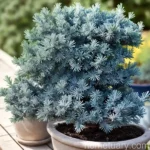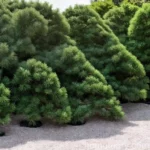Everything You Need to Know About Juniper (Juniperus Chinensis var. Sargentii)
Plants have always played a crucial role in the planet’s ecosystem, providing us with food, medicine, and even adding to the visual appeal of our environment. In this blog post, we are going to delve into the captivating world of Juniperus Chinensis var. Sargentii, also known as Sargent’s Chinese Juniper. Known for its versatility and unique features, this plant serves as an excellent addition to various landscapes, offering both aesthetic and practical benefits. We’ll explore its culture, uses, care requirements, propagation, common diseases, and much more. Sit back, relax, and let’s embark on this fascinating journey into the world of Juniperus Chinensis var. Sargentii.
What is Juniper (Juniperus Chinensis var. Sargentii)?
Juniperus Chinensis var. Sargentii, commonly referred to as Sargent’s Chinese Juniper, is part of the Cupressaceae family. This evergreen shrub is native to Korea, China, Japan, and Mongolia and is widely recognized for its striking features, making it a popular choice for a wide range of landscape designs.
Key Takeaways – Juniper (Juniperus Chinensis var. Sargentii):
- Scientific Name: Juniperus Chinensis var. Sargentii
- Other Names: Sargent’s Chinese Juniper, Sargent Juniper
- Variety: Juniperus Chinensis variety Sargentii
Now, let’s delve into the various aspects of this remarkable plant.
Culture
Understanding the cultural requirements of Juniperus Chinensis var. Sargentii is crucial for its successful growth and development. Here’s what you need to know about its culture:
- Region: Juniperus Chinensis var. Sargentii thrives in regions with temperate climates. It can tolerate a wide range of soil types and is adaptable to various environmental conditions.
- Usage: This plant is commonly used in landscaping, often employed as a ground cover, hedge, or border plant. Its adaptability makes it versatile for various landscape designs.
Uses
Juniperus Chinensis var. Sargentii serves a multitude of purposes, making it a valuable addition to any garden or landscape. Some common uses of this plant include:
- Landscaping: Its attractive foliage and growth habits make it an ideal choice for landscaping projects, where it can be used as ground cover, border plants, or specimen plants.
- Erosion Control: The dense growth of Juniperus Chinensis var. Sargentii’s foliage aids in controlling soil erosion, particularly on slopes and embankments.
- Privacy Hedge: With its dense growth and evergreen nature, this plant can be used to create natural privacy hedges, serving as a barrier against nosy neighbors or unwanted views.
- Medicinal Uses: Certain parts of the Juniperus Chinensis var. Sargentii plant have been used in traditional medicine for their potential medicinal properties.
Care Requirements
Caring for Juniperus Chinensis var. Sargentii involves understanding its water, sunlight, fertilizer, soil, and pruning needs. Let’s break down each of these essential care elements.
Water
Juniperus Chinensis var. Sargentii has moderate water needs. As with most plants, proper watering is critical to its overall health and growth. Here are some key points to consider regarding its water requirements:
- Establishment Phase: Newly planted Juniperus Chinensis var. Sargentii specimens should be watered regularly to help them establish a strong root system.
- Established Plants: Once established, these plants are relatively drought-tolerant and require watering only during extended dry periods.
Sunlight
Sargent’s Chinese Juniper thrives in full sun to partial shade. When choosing a planting location for this shrub, ensure it receives adequate sunlight for optimal growth and development.
Fertilizer
When it comes to fertilization, Juniperus Chinensis var. Sargentii has modest needs. A balanced, slow-release fertilizer applied in the spring can help support healthy growth. It’s important to follow the manufacturer’s instructions regarding the application and dosage of fertilizer.
Soil
Juniperus Chinensis var. Sargentii is adaptable to various soil types, but it thrives in well-drained soils. It’s essential to ensure that the planting site has good drainage to prevent waterlogged conditions, which can be detrimental to the plant’s health.
Pruning
Proper pruning is essential for shaping and maintaining the desired form of Juniperus Chinensis var. Sargentii. Regular pruning can also help remove dead or diseased branches, promoting overall plant health. When pruning this plant, ensure adequate air circulation and avoid cutting back into old wood where possible.
Propagation
Propagation of Juniperus Chinensis var. Sargentii can be achieved through various methods such as:
- Cuttings: Softwood cuttings can be taken in the early summer and rooted to propagate new plants.
- Seeds: While seeds are a viable option for propagation, the process is relatively slow, and the resulting plants may vary in characteristics from the parent plant.
Container Popularity
Due to its adaptability and compact growth habit, Juniperus Chinensis var. Sargentii is well-suited for container gardening. Its versatility and relatively low maintenance requirements make it an excellent choice for adding greenery to balconies, patios, and other outdoor spaces with limited ground area.
Container Common Diseases
When growing Juniperus Chinensis var. Sargentii in containers, it’s important to be aware of potential diseases that may arise, including:
- Root Rot: Overwatering can lead to root rot, a common issue in container-grown plants. Ensure proper drainage and avoid waterlogging the soil.
Disease Diagnosis
Juniperus Chinensis var. Sargentii is generally resistant to many diseases and pests, but it may occasionally encounter issues such as:
- Phomopsis Blight: This fungal disease can affect junipers, causing dieback and browning of the foliage.
- Cedar-apple Rust: While less common in Juniperus Chinensis var. Sargentii, it’s important to monitor for signs of cedar-apple rust, a fungal disease that affects various juniper species.
Common Pests
Pests can also pose a threat to the health of Juniperus Chinensis var. Sargentii. Some common pests to watch out for include:
- Spider Mites: These tiny pests can cause stippling and discoloration of the foliage, affecting the plant’s overall appearance.
- Juniper Scale: Scale insects can infest junipers, leading to yellowing of the foliage and potential plant stress.
Botanist’s Tips
As a plant scientist, I’d like to offer some tips for successfully growing and caring for Juniperus Chinensis var. Sargentii:
- Proper Spacing: When planting multiple Juniperus Chinensis var. Sargentii shrubs, ensure adequate spacing to allow for healthy air circulation and minimize the risk of disease.
- Monitoring Moisture Levels: Regularly check the moisture levels in the soil, especially when growing this plant in containers. Avoid overwatering, as it can lead to root rot and other issues.
Fun Facts
To add a touch of excitement to our exploration of Juniperus Chinensis var. Sargentii, here are some fun and intriguing facts about this remarkable plant:
- The name “Juniper” is derived from the Latin word “juniores,” which means “young” and refers to the plant’s youthful green foliage.
- Certain species of juniper are utilized in the production of gin, providing the beverage with its distinctive flavor profile.
Links to External Resources
For further information on Juniperus Chinensis var. Sargentii, as well as practical care tips and inspiration for incorporating this plant into your landscape designs, consider exploring the following external resources:
- Royal Horticultural Society – Juniperus chinensis
- Missouri Botanical Garden – Juniperus chinensis ‘Sargentii’
- University of Florida IFAS Extension – Juniperus chinensis for the landscape
- Dave’s Garden – Juniperus chinensis ‘Sargentii’
Juniperus Chinensis var. Sargentii continues to captivate enthusiasts and professionals in the gardening and landscaping realms, offering a blend of beauty, versatility, and resilience.
In conclusion, Juniperus Chinensis var. Sargentii, also known as Sargent’s Chinese Juniper, presents a myriad of opportunities for enhancing outdoor spaces and creating visually stunning landscapes. Its adaptability to various cultural conditions, minimal care requirements, and aesthetic appeal make it a valuable addition to gardens, parks, and public spaces. Whether utilized as a ground cover, border plant, or container specimen, this remarkable plant holds immense potential for elevating the beauty and functionality of outdoor environments.
We hope this comprehensive exploration of Juniperus Chinensis var. Sargentii has provided you with valuable insights and practical knowledge to further appreciate and cultivate this exceptional plant.
So go ahead, embrace the charm of Juniperus Chinensis var. Sargentii, and let your landscape flourish with its timeless elegance!















